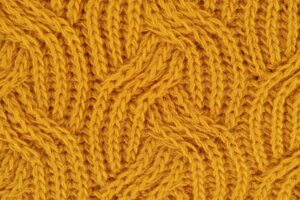Overview

Acrylic is a manufactured, petrochemical based fibre, it is produced as a filament but usually cut down to make a staple.
Acrylic is primarily used as an alternative to wool, designed to weigh less and be easier to care for. It is often also blended with wool to reduce the cost of the finished yarn/textile.
Common Fabrics

- Acrylic yarn for home knitters
- Serge
- Knits
- Herringbone
- Gabardine
- Felt
- Tweed
- Jacquard
Context of Use

- Acrylic is used in much the same context as wool. It is frequently used for cool weather apparel and accessories. This includes outerwear like coats and jumpers and accessories like scarves, gloves and beanies.
- Acrylic is used to make a synthetic felt, common used in crafts. The process differs to the wool felting process with the acrylic fibres being fused together chemically rather than being connected together through heat, water and agitation like traditional wool felt.
- Acrylic is often used in homewares as a low cost alternative to wool in things like carpets and blankets.
Care Guide
The following is a general guide to caring for this textile, however you should always refer to and follow the instructions on the care label of each garment.
How to Wash
Acrylic can be machine washed on a gentle cycle or hand washed.
Washing Temperature
Acrylic should be washed in cool (30C) to cold water.
Detergents and Bleach
Acrylic can be washed with regular laundry detergents.
Do not bleach.
Drying
Acrylic should preferably be line dried but can be dried on the coolest tumble drier setting.
Ironing
Acrylic can be ironed on the coolest iron setting.
Storing
Acrylic should be stored in a well ventilated space away from direct sunlight.
Recycle
- 100% Acrylic fabric can be recycled but the process isn't available at scale to the general public. Some apparel companies may take back acrylic garments.
Further Reading
You can learn more about acrylic at the following external links.